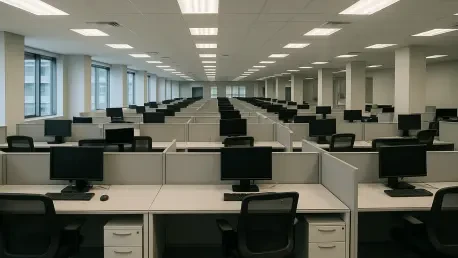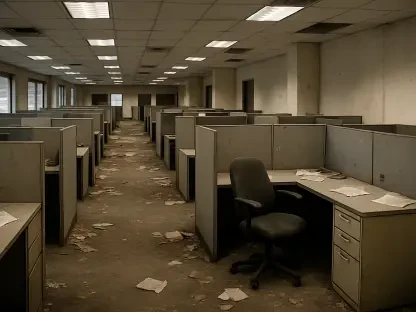What happens when the nation’s top public health protector is forced to dismantle its own defenses? Picture a country already battered by health crises now facing a severe blow to the very agency tasked with safeguarding lives. The U.S. Centers for Disease Control and Prevention (CDC) is reeling from federal budget cuts in 2025, with hundreds of employees receiving termination notices. This isn’t just about job losses; it’s about the unraveling of critical programs that shield communities from disease, violence, and environmental threats. The stakes couldn’t be higher as the nation watches this unprecedented downsizing unfold.
The Stakes of a Shrinking CDC
The CDC stands as the cornerstone of public health, a shield against outbreaks and a beacon for global health equity. Yet, with a sweeping federal initiative to slash government spending, at least 600 CDC staffers are being let go, part of a broader plan to eliminate 10,000 positions across health agencies. These cuts, driven by a policy to reduce federal footprints starting this year, threaten to erode the foundation of programs that millions depend on. From tracking deadly viruses to preventing child abuse, the agency’s mission is at risk, raising alarms about whether budget savings justify the potential cost to human lives.
This isn’t a distant concern—it touches every corner of society. The timing couldn’t be worse, as the nation still grapples with the scars of recent health emergencies. With fewer hands on deck, the ability to respond to the next crisis, be it a pandemic or a spike in violence, hangs in a precarious balance. The significance of these layoffs lies not just in numbers, but in the gaping holes they leave in public health infrastructure, prompting a national debate on priorities.
Unpacking the Devastation of the Cuts
The scale of the layoffs is staggering, with entire divisions feeling the axe. Violence prevention programs, crucial for combating rape, child abuse, and teen dating violence, are losing around 100 dedicated employees, undermining both domestic and international efforts. Other sectors, like the freedom of information office, remain vulnerable despite a federal judge’s ruling temporarily protecting areas such as reproductive health and environmental programs. The breadth of this overhaul, initiated in 2025, prioritizes fiscal reduction over sustaining vital services.
Beyond statistics, the human cost is evident. Programs that took years to build, like those tracking global violence against children, face dismantlement, leaving communities exposed to preventable harms. Data from past CDC reports indicates that violence prevention initiatives have reduced child maltreatment rates by up to 20% in targeted regions. Losing these resources now could reverse such progress, amplifying risks for the most vulnerable populations.
The ripple effects extend further. With fewer staff to monitor environmental hazards or respond to disease outbreaks, the nation’s readiness for emerging threats diminishes. This isn’t just a cut—it’s a gamble with public safety, where the immediate savings might pale against the long-term consequences of weakened health systems.
Echoes of Anger from the Ground
Inside the CDC, frustration festers among employees caught in the crosshairs of these cuts. The American Federation of Government Employees (AFGE), representing over 2,000 CDC staff, has slammed the lack of clarity surrounding the layoffs. A union spokesperson vented, “There’s no roadmap for who’s being let go or why, leaving everyone on edge.” This opacity from the U.S. Department of Health and Human Services (HHS), which confirmed the terminations but withheld specifics, fuels a growing distrust among workers and advocates.
Personal stories add depth to the discontent. A veteran violence prevention specialist shared a heartbreaking sentiment: “Decades of work to protect kids from abuse are crumbling before our eyes.” Such accounts highlight not just job loss, but the erosion of purpose for those who’ve dedicated careers to public service. The emotional toll compounds the practical challenges, as remaining staff brace for heavier workloads with fewer resources.
The broader sentiment reflects a crisis of accountability. Without transparent communication, assessing the full damage becomes impossible, leaving employees and the public scrambling for answers. This lack of dialogue between federal leadership and frontline workers underscores a disconnect that could hinder future collaboration on public health challenges.
What’s at Risk with a Diminished Workforce?
The consequences of these layoffs loom large over specific, critical areas of public health. Programs aimed at curbing domestic violence, a persistent issue affecting 1 in 4 women and 1 in 9 men according to CDC data, are directly hit. With staff reductions, interventions that have historically lowered these rates through education and community support face an uncertain future. Internationally, efforts to track and mitigate violence against children in conflict zones are also jeopardized, potentially stalling global progress.
Environmental health, another pillar of the CDC’s work, stands on shaky ground. Fewer experts mean delayed responses to hazards like lead exposure or air pollution, which still impact millions annually. A case study from a past crisis, where CDC intervention cut lead poisoning cases by 30% in affected communities, shows what’s at stake. Losing capacity now could mean slower action in future emergencies, with devastating outcomes for public wellness.
Moreover, the cuts threaten the agency’s ability to innovate. Research into emerging diseases, a lifeline during past outbreaks, relies on robust staffing. Diminishing this workforce not only hampers immediate responses but also stifles long-term advancements, potentially leaving the nation unprepared for health threats on the horizon.
Charting a Path Forward Amid Crisis
While the layoffs are already in motion, avenues exist to lessen the blow and protect public health. Stakeholders, from policymakers to everyday citizens, can demand greater transparency from HHS regarding which roles and programs face elimination. Clear information is the first step toward crafting effective responses and ensuring resources are allocated where they’re most needed. Public pressure could force a more open dialogue, holding decision-makers accountable.
Support for advocacy groups like AFGE offers another lifeline. By amplifying their efforts through community awareness and lobbying, there’s a chance to reverse some cuts or secure funding for critical positions. Lawmakers must also be urged to explore budget alternatives, such as reallocating funds or streamlining operations without sacrificing staff. These measures could preserve essential services while addressing fiscal concerns.
On a local level, state and community health departments can step in to bridge gaps left by federal reductions. Partnerships with nonprofits and grassroots initiatives might temporarily sustain programs like violence prevention until federal support is restored. These collective actions, though not a complete solution, provide a buffer against the immediate fallout, ensuring that public health remains a priority even in lean times.
Reflecting on a Troubled Chapter
Looking back, the massive layoffs at the CDC marked a pivotal moment of tension between fiscal policy and public welfare. The termination of at least 600 employees under federal budget cuts struck a blow to programs that had long protected communities from violence and disease. The lack of transparency from HHS deepened the frustration, leaving workers and advocates grappling with uncertainty about the full scope of the damage.
Yet, amidst the setbacks, pathways emerged for mitigation. Efforts to demand clarity, bolster advocacy, and foster local partnerships offered hope for preserving critical services. Moving forward, it became clear that safeguarding public health required a united front—urging policymakers to prioritize funding solutions and encouraging communities to rally around vulnerable programs. This chapter served as a stark reminder that the cost of cuts could never be measured in dollars alone, pushing society to rethink how it valued its protectors.









